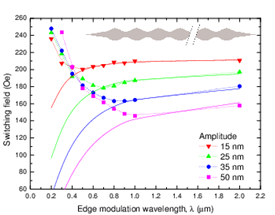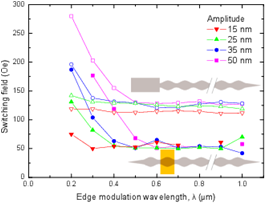
Magnetisation reversal and domain wall propagation in edge modulated nanowires
D.M. Burn and D. Atkinson
IOP Current Research in Magnetism workshop London Sep 2013
The behaviour of domain walls in magnetic nanowires has received significant interest due to the potential for the development of novel spintronic devices. High operation speeds, reliability and packing density are important factors for the success of such devices. However, Walker breakdown [1] at high driving fields affects the wall chirality and limits domain wall mobility in both nanowires [2] and thin film [3] structures.
Nanowires with rough edges show improved domain wall mobility due to interactions between the domain wall and nanowire structuring.4 Here, artificial roughness is introduced in the form of periodic modulations to a nanowire's edge geometry. Experiments and micromagnetic simulations are used to investigate the influence of the modulation upon both the static and dynamic magnetisation processes.
Field driven reversal processes in these wires were investigated first via direct reversal from an initially uniform magnetisation state at a relatively high field and then through domain wall mediated reversal at lower fields. Experimentally determined reversal fields are shown in figures 1(a) and 1(b) for these two reversal modes respectively. These results have been interpreted using micromagnetic simulations and through the development of a model based on the demagnetisation effects of the modulation upon the spin structure of the wire.
Further micromagnetic simulations were used to investigate dynamic domain wall processes. Matching the periodicity of the wire structuring to the frequency of Walker breakdown structural transitions leads to the suppression of Walker breakdown by triggering energy dissipation through spin wave emission[5].


Figure 1: Magnetisation reversal field for a nanowire as a function of edge modulation wavelength. a) Direct nucleation limited reversal where the lines show the best model fit to the long wavelength data and b) domain wall mediated reversal using nucleation pad and stripline domain wall injection techniques.
[1] N.L. Schryer and L.R. Walker J. Appl. Phys. 45, 5406 (1974).
[2] G.S.D. Beach, C. Nistor et.al. Nat. Mater. 4, 741 (2005).
[3] D.M. Burn and D. Atkinson J. Appl. Phys. 108, 073926 (2010).
[4] Y. Nakatani, A. Thiaville and J. Miltat Nat. Mater. 2, 521 (2003).
[5] D.M. Burn and D. Atkinson Appl. Phys. Lett. 102, 242414 (2013).